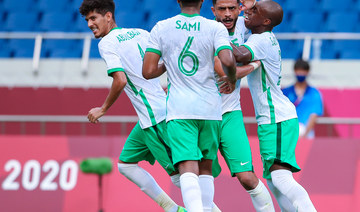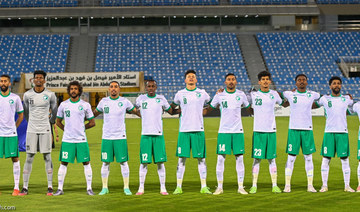RIYADH: Now the Olympics football tournament is over, attention has quickly turned to the start of the new Saudi Professional League (SPL) season next week.
Take a quick look at the headlines and social media and there is not much being said about what happened in Japan as the young Falcons lost all three games at Tokyo 2020. But there are the usual significant number of reports and rumors as to which foreign stars are heading to the league. The two are connected, however.
There is no doubt that there are some top-class foreign players in Saudi Arabia who bring a lot to their clubs and the league. Stars such as French striker Bafetimbi Gomis and Syrian sharpshooter Omar Al-Somah light up the league on and off the pitch.
Looking ahead to the new season there will be speculation about whether Al-Hilal will make it three in a row or if Al-Ahli will return to the running, but there is one certainty: The top scorer next season will not be Saudi Arabian.
Saudi Arabia’s league is unusual in Asia in that it does not limit the number of foreign players to four in the way many do, with each club allowed to sign and field seven overseas footballers.
And it is no surprise that attackers from around the world are in demand. After all, scoring goals is the hardest thing in football to do, so why would clubs and coaches not look to import solutions?
Gomis, a powerful, skillful striker, fiery yet with ice-cool composure in the area, is one of the best center-forwards in Asia. He was the top scorer in the 2019 AFC Champions League as Al-Hilal picked up a third continental championship. Others played their part but the former French international made the difference at crucial times. The likes of Abderrazzak Hamdallah of Morocco and Cristian Guanca of Argentina were other stars last season.
It is not just the title-chasing clubs that have goal scorers from abroad. Swede Carlos Strandberg scored 16 goals, more than a third of Abha’s total in the SPL, and those strikes played a major part in the club staying up by a point.
In short, in Saudi Arabia, all the teams look to foreigners for goals. This can help the local defenders gain some vital experience in facing a variety of strikers from all over the world. For young center-backs there can be few better learning curves available than one which features clashes against the physical Gomis, the artful Guanca, and the single-minded Strandberg.
This attacking talent can flourish anywhere in the world and if any defender can learn to hold their own against them then they have nothing to fear and plenty to look forward to.
But what about the local strikers? There are consequences for this love of international attackers. Increasingly the home-grown forwards are getting fewer chances to develop. Just look at the goalscoring charts for last season; none of the top 10 were from Saudi Arabia. The highest-ranked was Hassan Al-Amri at No. 12 and seven of his 12 goals for Al-Qadisiyah came from the spot. In contrast, six of the most prolific 10 players in Japan were locals.
This is obviously a worry. If teams look overseas for striking talent, then there are fewer opportunities for locals.
At the Olympics, many hopes were placed on the shoulders of Abdullah Al-Hamdan who made headlines when signing for Al-Hilal from Al-Shabab in January. It was hoped that the 21-year-old was the answer to the search for the next Sami Al-Jaber. Yet the forward struggled to get into games in Japan, looked off the pace, and was easy for defenders to handle. That should not be a surprise given that he has been a bit-part player for Al-Hilal, playing a full league game just once since joining the club.
If he cannot get a run of games then he is unlikely to be able to make the difference against defenders from the Ivory Coast, Germany, and Brazil.
And if it was not tough enough for the player last season, Al-Hilal have added Moussa Marega from Porto. The 30-year-old Malian marksman scored plenty in Portugal and is likely to slot straight into the starting line-up when the new season kicks off.
So, what is a promising young striker such as Al-Hamdan to do? If he does not get much playing time, then he has to move but the same issues exist in other clubs in Saudi Arabia. Moving overseas may be the answer but is not an easy one, especially when Saudi strikers have little reputation internationally, partly due to the fact that they are squeezed out of their starting elevens at home.
Nobody could blame a coach for pushing a talented young player in Riyadh or Jeddah toward midfield or the wings. It is a vicious circle. While foreigners dominate the scoring charts, the demand for them will continue to rise. This reduces the chances for the locals; if they are not playing, they are not scoring, and so clubs continue to look overseas.
There is no easy answer or quick fix but reducing the number of imports from seven to four would be a step in the right direction.














